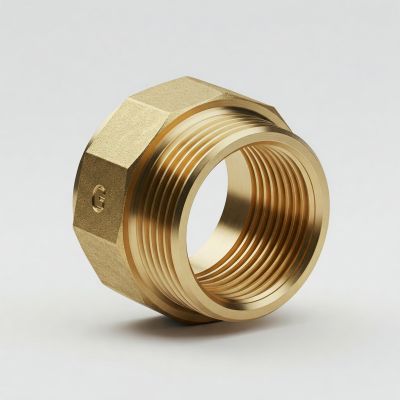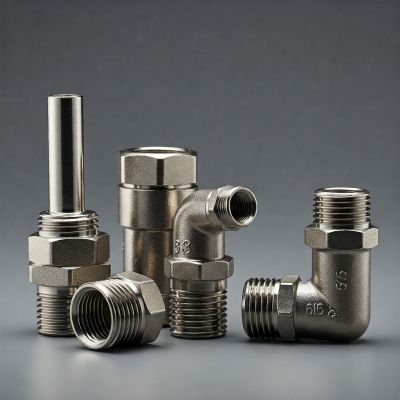Different thread standards play a crucial role in ensuring secure and leak-free connections in plumbing, hydraulics, and industrial applications. Among the many thread types, G threads and BSPP (British Standard Pipe Parallel) threads are often mentioned together, leading to confusion about their similarities and differences.
Understanding the distinctions between these two thread types is essential for selecting the right fitting and achieving a reliable seal. In this article, we will explore G threads and BSPP threads, their characteristics, key differences, and best practices for their application.
Understanding G Threads and BSPP Threads
What Are G Threads?
G threads are parallel (non-tapered) threads standardized under ISO 228-1. They are widely used in Europe and other international markets for plumbing, hydraulic, and pneumatic systems. Unlike tapered threads, which rely on thread deformation for sealing, G threads require additional sealing components, such as washers or O-rings.
Characteristics of G Threads:
➡️ Parallel (straight) thread design
➡️ ISO 228-1 standardization
➡️ Requires a sealing washer or gasket for leak prevention
➡️ Used in water, gas, and air applications
Common Applications of G Threads:
➡️ Water supply systems
➡️ Hydraulic and pneumatic connections
➡️ Gas fittings
➡️ Industrial machinery
What Are BSPP Threads?
BSPP (British Standard Pipe Parallel) threads are also parallel threads, standardized under BS EN 10226 and ISO 228-1. BSPP threads, like G threads, require a separate sealing element, such as an O-ring or bonded washer, to create a tight seal.
Characteristics of BSPP Threads:
➡️ Parallel (non-tapered) thread profile
➡️ Standardized under ISO 228-1 and BS EN 10226
➡️ Utilizes O-rings or bonded seals for sealing
➡️ Common in fluid and gas transport systems
Common Uses of BSPP Threads:
➡️ Hydraulic and pneumatic systems
➡️ Fuel and gas lines
➡️ Plumbing and industrial fittings
➡️ Pressure gauges and sensors
Key Differences Between G Threads and BSPP
1. Thread Design and Structure
Both G threads and BSPP threads share a parallel thread design, meaning they do not taper. The primary difference lies in their naming conventions and industry terminology.
➡️ G threads are a subset of BSPP threads, as both follow ISO 228-1 standards.
➡️ While BSPP is widely used in industrial applications, G threads are more commonly referenced in plumbing and gas systems.
2. Sealing Method
One of the most significant differences between G and BSPP threads is their sealing mechanism.
➡️ G threads require a sealing washer or gasket placed between the mating surfaces to prevent leaks.
➡️ BSPP threads often use bonded seals, O-rings, or face seals for leak prevention.
➡️ BSPT (British Standard Pipe Taper) threads, in contrast, achieve sealing by thread deformation rather than using additional seals.
3. Applications and Compatibility
While both thread types are similar, their applications can differ slightly.
➡️ G threads are commonly used in fluid transfer, compressed air systems, and gas distribution.
➡️ BSPP threads are more frequently found in hydraulics, pneumatics, and industrial fittings.
Can G Threads and BSPP Be Used Interchangeably?
Yes, G threads and BSPP threads can often be used interchangeably, as long as the correct sealing method (e.g., O-rings, washers) is applied. However, it is essential to verify compatibility with existing fittings before installation.
How to Identify and Choose the Right Thread
Methods for Identifying G vs. BSPP Threads
To distinguish between G and BSPP threads, consider the following methods:
-
Use a Thread Pitch Gauge – Measure the thread pitch and compare it with ISO 228-1 standards.
-
Check for Parallel vs. Tapered Design – Both G and BSPP threads are parallel, while BSPT threads are tapered.
-
Inspect Standard Markings – Many fittings are labeled with thread standards (e.g., G1/2, BSPP1/2).
-
Use Calipers – Measure the major and minor diameters to ensure compatibility.
Factors to Consider When Choosing the Right Thread Type
➡️ Application – Consider whether the fitting will be used in hydraulic, pneumatic, gas, or water systems.
➡️ Sealing Requirements – Choose the correct sealing method (e.g., washers, O-rings) to prevent leaks.
➡️ Compatibility – Ensure that the selected thread matches existing fittings and standards.
Best Sealing Practices for G and BSPP Threads
➡️ Always use the correct sealing washer, O-ring, or bonded seal.
➡️ Avoid over-tightening, as it can damage threads or sealing components.
➡️ Apply thread sealant only if the manufacturer recommends it (not typically required for parallel threads).
Conclusion
G threads and BSPP threads are often confused due to their similar design and ISO 228-1 standardization. However, while G threads are considered a subset of BSPP, they have distinct applications and sealing requirements.
Key Takeaways:
➡️ Both G and BSPP threads are parallel (non-tapered) and follow ISO 228-1.
➡️ G threads require sealing washers, while BSPP threads often use O-rings or bonded seals.
➡️ They can be used interchangeably in many cases, provided proper sealing techniques are used.
➡️ Proper identification using gauges, calipers, and standard markings ensures the correct selection.
Understanding these differences ensures secure, leak-free connections in plumbing, hydraulic, and industrial applications. By choosing the right thread type and sealing method, you can improve system efficiency and avoid costly installation errors.
Post time: Feb-21-2025



